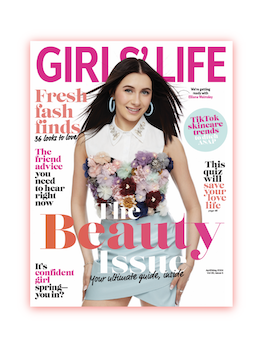HEALTH
Your Bod
Everything you need to know about switching to contact lenses
For all my girlies without perfect 20/20 vision: Have you been thinking about swapping out your glasses for contacts? While there's nothing wrong with wearing glasses (and they can *def* be a look), always having them on your face can be annoying sometimes, especially if you're an athlete. So how do you make the switch, and what do you need to know? Keep reading to find out.
Soft vs. hard contacts
One factor to consider with your optometrist when choosing contacts that are right for you is if they will be soft or hard. Soft contacts are generally characterized as being the most comfortable and easy to wear. Like the name suggests, they are made of a more soft and flexible material to mold to your eye. However, they are less durable than hard contacts and usually need to be replaced more often. Hard contacts, on the other hand, don't change shape as easily, which can help slow nearsightedness or astigmatism.
Daily, monthly, weekly?
Another thing to keep in mind is the amount of time you'll have before needing to replace your contact lenses. The most common prescriptions are daily and monthly contacts, but there are also biweeklies and others. Some find daily contacts to be more convenient because daily disposals don't force you to clean them every day, and they can be more convenient for those who don't wear contacts on a regular basis. Monthly contacts are often less expensive than daily contacts, and they result in less environmental waste as well.
Cleaning your contacts
Hygiene, hygiene, hygiene! Your optometrist will give you the full rundown on how to care for your contacts, but be super mindful of your new responsibilities with cleaning them. Always wash your hands thoroughly before handling your contacts, clean your case and use the proper solutions.
Putting them in and taking them out
We know—learning how to put in contacts and take them out seems like the scariest part! Seemingly touching your eyeball can look impossible at first, but we promise that it just takes practice. Ask your optometrist for help, and even watch some tutorials on YouTube. You *can* do it, and it isn't some dangerous, unsanitary thing (as long as you're always washing your hands before).
Eyedrops
Here's another thing for you to consider: do you have dry eyes? If you're always on your devices and find yourself having to blink constantly, contacts may make your eyes feel even drier. But there's a fairly simple solution: eyedrops. There are so many lubricating eye drops that come in small, portable packaging for you to throw in your bag and whip out whenever your eyes need some extra tears. Don't let your dry eyes stop you from trying out contacts.
Speak with your optometrist
Above all, just contact your optometrist with any and all questions you have. Your medical professional will work with you to figure out what types of contacts will work best for *you* and your needs, and they'll help you throughout the process of learning aftercare and taking them in and out.
For all the girlies with glasses, check out these posts for more:
✨ The *ultimate* guide to wearing glasses with makeup
✨ Why blue light glasses are *so* important (and where to get cute ones)
✨ A beginner's guide to wearing contacts
Let us know about your contact lens journey on Twitter @girlslifemag!
We want to hear from you! Send us your weirdest body questions here (seriously, we'll answer anything!) and it just might get featured.

 become a contributor
become a contributor


















